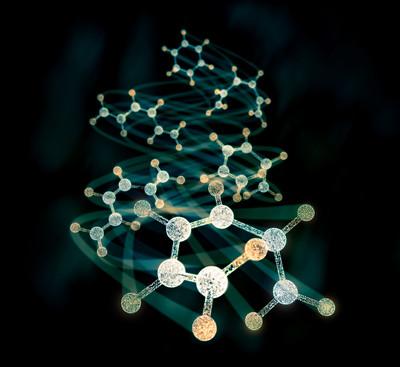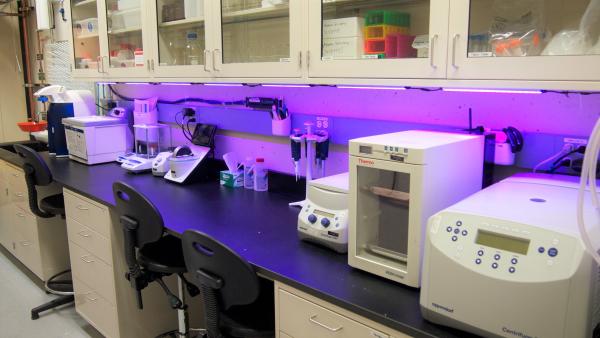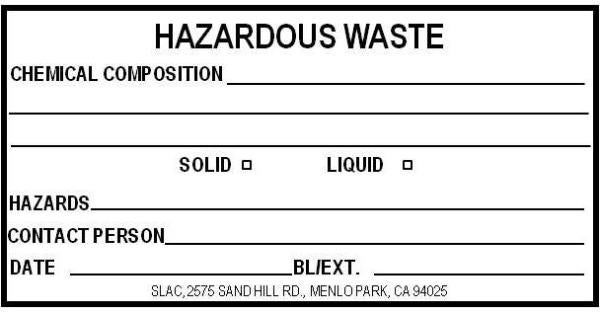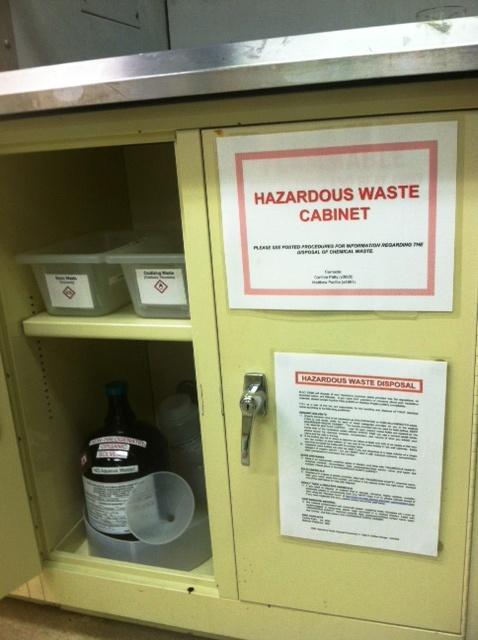Sample Preparation Laboratories (SPL)
There are two LCLS Sample Preparation Laboratories (SPLs). The Far Experimental Hall (FEH) wetland (image above right) is a small general use lab located in Rm 109 of the FEH servicing the MEC, CXI, MFX, and XCS hutches. The Near Experimental Hall (NEH) wet lab (image above left) is a small general use lab located in Rm 112 of the NEH servicing the ChemRIXS, TMO, TMI and XPP hutches. Both labs are located conveniently close to their respective beam lines in order to facilitate final stage sample preparations immediately prior to and during the beamtime. Space is limited in both labs, so certain experimental activities may be limited or moved to the Arrillaga Science Center labs. All access must be schedule in advance by filling out the User Access Agreement. Lab bench spaces are typically assigned for 2 days prior to 2 days after the experiment. Lab training is required for access, for specifics see the SPL access tab on the left.
Further information can be found in the tabs below including, how to gain access to the labs, the chemical/equipment resources available in the labs, how to handle laboratory waste, and other necessary resources for the use of the SPLs.
Planning Ahead

Please complete the Beam Time Request (BTR) and Support Request forms through the User Portal. Thorough chemical and sample information must be included in your BTR. Support Request forms include a list of collaborators that require laboratory access and your group's laboratory equipment requests. Researcher safety is of prime importance at SLAC. Please remember that radioactive materials, nanomaterials, and biohazardous materials have additional safety requirements. Refer to the LCLS Safety Office for further guidance.
Upon Arrival
Lab safety orientation must be completed on arrival. Access to Sample Preparation Labs are RFID controlled and can only be activated upon successful completion of the training. Once your SPL access procedures are complete you will receive the RFID access.
1. Sample Preparation Laboratory Training, Course 204
Access can be obtained by completing a two-part training including an online Sample Preparation Laboratory training, Course 204, and an in-person orientation at B999-RM 109. Training expires one year from the date of completion. The online training is 30 minutes in length and covers lab policy, resources, safety, and emergency information. In-person orientation covers building and lab safety features.
To make an appointment please contact your experimental POC and SPL lab manager. Please make sure to complete the online course prior to scheduling the in-person orientation. LCLS training slots must be reserved in advance due to space limitations within the LCLS lab.
Read more about SPL training course 204

2. User Access Agreement
A new User Access Agreement (UAA) needs to be submitted and approved for every beam time. The UAA requires a list of chemicals and samples for your experiment that will be present on-site during the beam time along with contact details for all personnel that are on-site during the experiment. Please contact your POC for any questions and concerns.
After Hours Arrival
If you plan to arrive at SLAC outside of normal business hours, please make prior arrangements with your POC and Christopher Kupitz.

All Sample Preparation Labs are stocked with an assortment of common solvents, acids, bases, buffers, and other reagents. See our Chemical Inventories for a list of available reagents. Chemical inventories are organized according to the Stanford Compatible Storage Group Guide. If you need large quantities of any chemicals, please order or bring your own supply (see below). Please obtain the Lab Manager's permission before using or removing chemicals from the laboratories.
Standard Operating Procedures (SOPs)
If you will be working with any samples or reagents that are significantly toxic, reactive, corrosive, flammable, or otherwise especially hazardous, we may require an approved SOP before you can begin work. Examples: Reagents with an NFPA Rating of 3 or 4 in any category, nanomaterials, heavy metals, pyrophoric materials, water reactive materials.
Blank SOP LCLSNanomaterial Checklist
Ordering Chemicals
All chemical orders must be placed through SLAC’s chemical procurement system; you cannot direct ship chemicals from a supplier to SLAC. Please contact us for ordering requests at least 3 weeks in advance. Provide the following information: chemical name, manufacturer’s name, part number, size, date required, user account number, Safety Data Sheets, and a 1-2 sentence description of chemical handling plans.
Shipping Chemicals & Samples
If you are shipping chemicals and/or samples to and from LCLS, please see the Shipping Equipment & Materials page.
Bringing Chemicals & Samples
If you are planning to transport your chemicals or samples to SLAC, strict adherence to Department of Transportation rules is required. Please contact Sample Prep Lab Staff or the LCLS Safety Office for approval and guidance.
Using Lab Chemicals
All chemicals in the lab are available for User's use. Please obtain the Lab Manager’s permission before removing chemicals from the laboratories, and inform them when a bottle is getting below 25% full.
Hazardous Waste
All waste produced in the Sample Prep Labs should be appropriately disposed of at SLAC. You are prohibited from transporting waste back to your home institution. Designated areas exist in the labs for sharps, broken glass, and hazardous waste. Sharps, broken glass, and hazardous waste must never be disposed of in the trash cans or sink drains.
Containment

Bottles, jars, and plastic bags are available for containing chemical waste. Place hazardous waste in an appropriately sized container and ensure it is tightly sealed. Separate solid waste from liquid waste (e.g. kimwipes from acid). Do not mix incompatible wastes (e.g. flammable solvent with oxidizer).
Labeling

All hazardous waste must be labeled. Labels, found on hanging rolls in the lab, must include chemical name and approximate concentration, physical state, relevant hazards, your name, the date, and the beamline or extension where you can be reached. It is required that you provide approximate concentrations for any heavy metals such as lead, mercury, selenium, arsenic, chromium, cadmium, and silver.
Disposal

Once contained and labeled, hazardous waste should be placed into the lab’s hazardous waste cabinet. Waste should be segregated by hazard type into the appropriate bin.
Non-hazardous Lab Waste
Non-hazardous lab waste like proteins, biological buffers, and salts may be eligible for sink disposal. Candidates for sink disposal must be approved by the lab manager in advance.
Special Considerations
If you plan on producing large volumes of waste, please let us know before you begin your experiment.
SPL/ ASC Contact Info
Maithri Kashipathy
LCLS Lab manager
Office: (650) 926-2391
maithri@slac.stanford.edu
Brandon Hayes
LCLS Science and Engineering Associate
Office: (650) 926-2995
Cell: (408) 660-7419
bhayes@slac.stanford.edu
Christopher Kupitz
LCLS Research Lead
Office: (650) 926-5408
ckupitz@slac.stanford.edu
Marc Weibel
LCLS Safety Officer
Office: (650) 926-4264
weibelm@slac.stanford.edu

